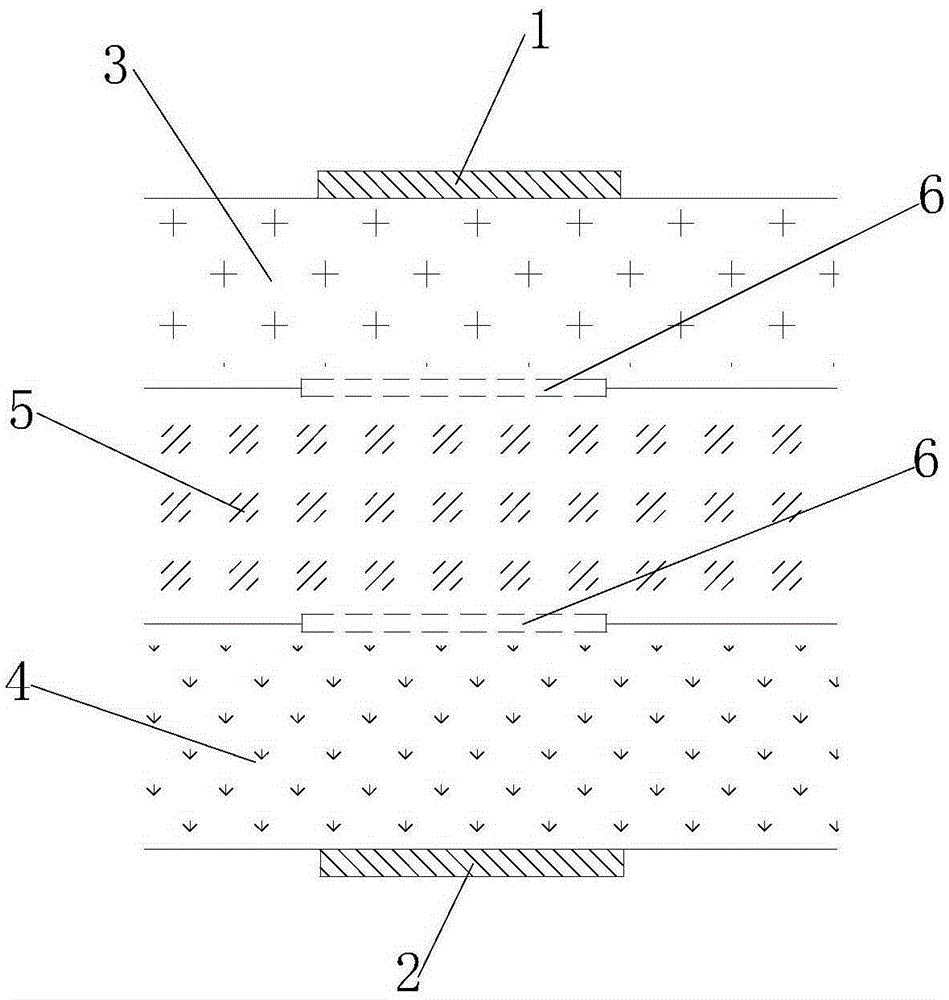Method for realizing cell switching of multi-electrolyte battery by using conduction of electrolytes
A battery cell and electrolyte technology, applied in the field of multi-electrolyte battery cell switch, can solve the problems of energy loss, failure to turn off the battery, limit the selection range of battery cathode and anode materials, etc., to achieve double protection and improve safety Effect
- Summary
- Abstract
- Description
- Claims
- Application Information
AI Technical Summary
Problems solved by technology
Method used
Image
Examples
Embodiment 1
[0023] Such as figure 1 As shown, a multi-electrolyte battery of the present embodiment, the multi-electrolyte battery includes an anode plate 1, a cathode plate 2, and an electrolyte, and the electrolyte includes an anolyte 3, a catholyte 4, and a bridge electrolyte 5. The anolyte 3 is in contact with the anode plate 1, the catholyte 4 is in contact with the cathode plate 2, and the bridge electrolyte 5 is placed between the anolyte 3 and the catholyte 4 to form an ion conduction channel, And separated by ion exchange membrane 6 respectively.
[0024] The anode plate 1 and the cathode plate 2 of the present embodiment are in contact with the anolyte 3 and the catholyte 4 respectively and undergo an electrochemical reaction, and the bridge electrolyte 5 passes through the ion exchange membrane 6 and the anolyte 3 and the catholyte respectively. 4 Selective conduction of ions, the battery cathode and anode materials do not need to be compatible with an electrolyte at the same ...
Embodiment 2
[0027] This embodiment provides a method for realizing the above-mentioned multi-electrolyte battery cell switch by using the conduction of the electrolyte, including the following steps: draining any one of the electrolytes, so that the electrolytes are in non-conduction state, the ion conduction channel is cut off, and the battery stops working. As mentioned above, the bridge electrolyte 5 selectively conducts ions through the ion exchange membrane 6, the anolyte 3, and the catholyte 4 to form ion conduction channels, so that the anode plate 1 and the cathode plate 2 are connected to the anode plate 2 respectively. When the electrolyte 3 and the catholyte 4 are in contact and electrochemical reaction occurs, the battery is in a working state. When the electrolyte is in a non-conductive state through control, and then the ion conduction channel is cut off, it is convenient to realize the When the battery is turned off, the battery cell itself has the function of a battery swi...
Embodiment 3
[0032] This embodiment provides a method for realizing the above-mentioned multi-electrolyte battery cell switch by using the conduction of the electrolyte, which includes the following steps: replacing any one of the electrolytes with an insulating liquid, so that the electrolytes are in a non-conductive state. In the conduction state, the ion conduction channel is cut off, and the battery stops working.
[0033] As a preferred solution, if the bridge electrolyte 5 is replaced with an insulating liquid, the ion conduction channel will be cut off, and the battery will stop working.
[0034] As another preferred solution, if the catholyte 4 is replaced with an insulating liquid, the ion conduction channel will be cut off, and the battery will stop working.
[0035] As another preferred solution, if the anolyte 3 is replaced with an insulating liquid, the ion conduction channel will be cut off, and the battery will stop working.
[0036] Wherein, the insulating liquid is a fluo...
PUM
 Login to View More
Login to View More Abstract
Description
Claims
Application Information
 Login to View More
Login to View More - R&D
- Intellectual Property
- Life Sciences
- Materials
- Tech Scout
- Unparalleled Data Quality
- Higher Quality Content
- 60% Fewer Hallucinations
Browse by: Latest US Patents, China's latest patents, Technical Efficacy Thesaurus, Application Domain, Technology Topic, Popular Technical Reports.
© 2025 PatSnap. All rights reserved.Legal|Privacy policy|Modern Slavery Act Transparency Statement|Sitemap|About US| Contact US: help@patsnap.com

